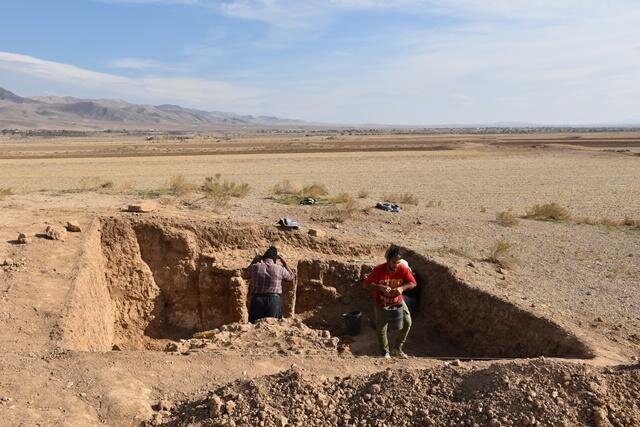Ruins of fortified monument unearthed in northeast Iran

TEHRAN – A team of Iranian and French archaeologists has discovered the ruins of a massive monument in Viranshahr, northeast Iran.
Based on initial evidence, experts from the Louvre and the University of Tehran estimate that the fortified structure had a religious or administrative use in its heyday, ISNA reported on Saturday.
The discovery was made during the fourth season of excavation on the site co-directed by Labbaf-Khaniki of Iran’s Research Institute of Cultural Heritage and Tourism and Louvre Museum’s Rocco Rante from the University of Provence Aix-Marseille.
This season is a follow-up excavation aimed to sharpen the focus on hidden gems of cultural heritage in Viranshahr, which is situated near the city of Faruj in North Khorasan province, the report said.
According to Labbaf-Khaniki, their joint investigations indicate the existence of a 14-hectare settlement once surrounded by a defensive wall. “And in the northern corner, there was another enclosed section, which probably formed the seat of the rulers of this settlement as a citadel.”
“Evidence suggests that towers were built at successive intervals along the wall, while small and large architectural structures were erected on the site, which can be seen today in the form of irregular mounts.”
In the current season of excavation, archaeologists managed to shed new light on the structure of the gate, including its entrance passage and rectangular cube tower, the archaeologist said.
In addition, excavations conducted on a southern hill revealed a monument that bears three-meter-wide clay walls. It may be either a religious or governmental monument based on available evidence.
The preliminary results of the current archaeological season indicated that Viranshahr was one of the most important population centers in the northeastern region of Iran due to the political and defensive importance of the Atrak valley during the Parthian and Sassanid periods, the archaeologist explained.
Follow-up excavations are expected to provide valuable information about the history of Persian architecture and pottery traditions in the Khorasan region during the mentioned period, he said.
Italian archaeologists, who identified this area before the 1979 Islamic Revolution, suggested its antiquity equivalent to the Sassanid period, the report said.
According to Labbaf-Khaniki, many historians and archaeologists believe Viran-Shahr is the birthplace of the Parthian Empire (247 BCE-224 CE), accommodating the first administrative institutes of the dynasty.
Parthian Empire (247 BC– 224 CE), also known as the Arsacid Empire, largely adopted the art, architecture, religious beliefs, and royal insignia of their culturally heterogeneous empire, which encompassed Persian, Hellenistic, and regional cultures. At its height, the Parthian Empire stretched from the northern reaches of the Euphrates, in what is now central-eastern Turkey, to eastern Iran.
The Sassanid era (224 CE–651) is of very high importance in the history of Iran. Under Sassanids, Persian art and architecture experienced a general renaissance. Architecture often took grandiose proportions, such as palaces at Ctesiphon, Firuzabad, and Sarvestan, which are amongst the highlights of the ensemble.
Khorasan -- meaning the “Land of the Sun” -- is a historical region and realm comprising a vast territory now lying in northeastern Iran, southern Turkmenistan, and northern Afghanistan. The historical region extended along the north, from the Amu Darya (Oxus River) westward to the Caspian Sea and, along the south, from the fringes of the central Iranian deserts eastward to the mountains of central Afghanistan.
The history of the area stretches back to very ancient times. It was part of the Achaemenian Empire of the 6th to 4th century BC and the Parthian empire, which spanned from the 3rd century BC to the 3rd century CE.
AM
